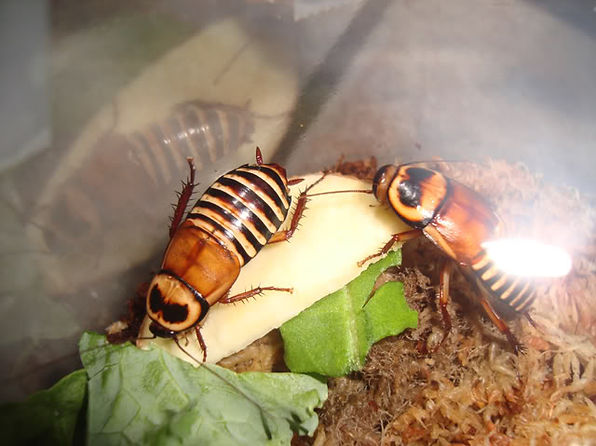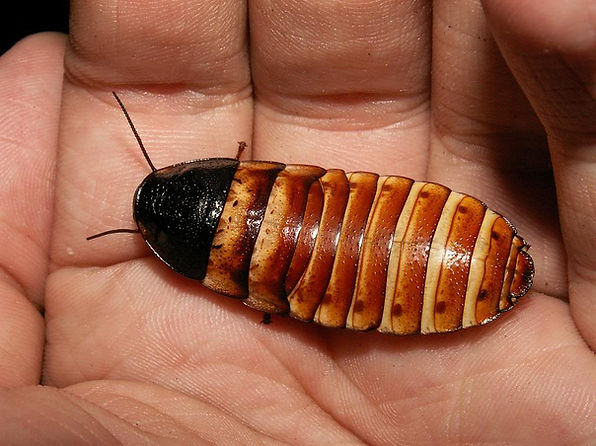Malaysian zebra-stripe cockroach Dorylaea orini
This site is dedicated to all roach enthusiasts. Allpet Roaches' goals are to promote the hobby and provide information and photogaphs on all the incredible looking cockroach species available. Less than 1% of roach species are pests, 99%+ survive indoors only as pets. They require nurturing to survive but the care requirements are easier and less expensive than those of other pets.
Allpet Roaches began in 1980 with a gift of three male and three female Madagascan Hissing Cockroaches from a director of the Cleveland Aquarium. Allpet Roaches came online in 1998 and a message board (forum) for enthusiast's was added to the site in 1999. The Allpet Roaches book was pulished in 2000. The forum was moved to a different address in December 2001 and to a greatly improved format in July 2007.

Malaysian zebra-stripe cockroachDorylaea orini
Where found: Malaysia.
Adult size: 30-35mm (1 to 1 2/5in).
This beautiful new addition to the hobby is also a new addition to described species in the genus Dorylaea. It was recently described by Dr. Luis M. Roth of Harvard. D. orini sports the most striking nymphs and the adults are somewhat pretty in their own right. This species is easy to keep in culture with moderate care. Petroleum jelly can be placed on the upper edges of the cage to hamper climbing.



Ornate Velvet Roaches Deropeltis paulinoi
Zebra roach Eurycotis decipiens
Where found: Costa Rica.
Adult size: 24-32mm (1 to 1 1/4in).
For noticeable reasons this creature is called the Zebra cockroach. This striking, medium-size species is pretty both as adult and nymph. It can't fly but relies on warning coloration and defenses. The large cerci enhance the ability to escape by sensing the direction of the oncoming predator. The Zebra roach lays medium sized eggcases, slightly larger than those of Periplaneta americana. The ability to scale smooth surfaces is evident in this species but can be easily kept under control by liberal application of petroleum jelly to the top 51mm (2inches) of the sides of the rearing container.



Eurycotis decipiens; Zebra Cockroach
Skunk roach Eurycotis floridana
Where found: Florida, U.S.A.
Adult size: 24-40mm (1 to 1 and 3/4 inches).
A fellow roach hobbyist who keeps them says they smell like Amaretto, and he likes the smell. He is crazy! This adult is by far the largest of the egglaying species commonly kept and the eggcases are huge too. The background color of E.floridana is a strange maroon. In nearly all culture stocks, the medium-sized nymphs have yellowish margins along the sides of the thoracic segments but the adults are always completely maroon. There is also a rare culture stock from the Keys in which the adults retain the nymphal striping. 1st instar nymphs of this species are oddly able to (slowly) walk right over Vaseline so a sealed container is necessary.


Skunk roaches - eurycotis floridana update
Ornate Velvet Cockroach Deropeltis paulinoi
Adult length: 32-38mm (1.1-1.3").
Where found: Angola, Botswana, Congo, Namibia, Zambia -Africa
Nymphs are orange with a large black central marking for the first few intstars but later change over to black with orange markings like the adult female pictured. The fully winged adult male looks like a small version of the Black Velvet roach Deropeltis erythrocephala male. It is a glass climbing species and is oviparous.
Porcelain roach Gyna lurida
Adult length: 20-35mm (3/4 to 1 and a half inches).
Where found: Kenya, Africa
Gyna lurida Porcelain Roach



Although adults of this Gyna species are often drab, there are occasional spectacular yellow adults (around one in fifty). Nymphs are always very handsomely marked in mottled black and white. Adult males are small and brown while females are twice as big and most often a delicate porcelain color. They possess incredible nervous energy but nymphs can't climb. The day active adults fly and jump like crazy and can take off from ground level.





Orange Head Cockroach (Eublaberus posticus) Wrestling Match
Orange head roach Eublaberus posticus
Where found: South America.
The Orange head roach is a very colorful species considering it is nearly two inches long. Most roaches with much color are less than an inch. Orange head roaches have neat looking, deep maroon nymphs, which like to spend their lives buried under the substrate. E. posticusare among the more prolific of the pet roaches and with care will outgrow a large rearing container quickly. It is necessary to keep a bit of available protein on hand, such as dog food, to reduce wing biting. They are horrible wing biters. This is also the only roach I have seen that will actually eat other insects with zeal; any insect unable to get out of harms way is devoured. This species is one of the easily contained Blattodea since it is unable to climb smooth surfaces. Inability to climb glass is caused by the way the tarsi are structured. Eublaberus distanti , the Six Spotted Cockroach, has a similar body but is colored in tan and lacks the hunger for live food. The common name 'six spotted' refers to the six yellowish spots on the brown nymph.



Dwarf Madagascar hissing cockroach Elliptorhina Chopardi
Where found: Madagascar.
Adult length: 36-42mm (+-1 1/2 inches)
The Dwarf Madagascar roach is a very neat little creature and is easy to distinguish from the following sp. by the v-shaped horn formation on the male and smaller size. The coloration is generally different from Gromphadorhina but both species have somewhat variable colors. This species does not have a defensive smell and is not very fast but does have the ability to climb glass.E.chopardi females are ovoviviparous and give birth to 20-30 tiny young.
Pacific beetle mimic Diploptera punctata
Where found: Asia and Pacific islands including Hawaii.
The Pacific beetle mimic cockroach is certainly one of a kind. This is the only species of cockroach known to reproduce by vivipary. Females of other cockroaches produce eggcases which are either left to the environment or drawn back into the body for incubation. D.punctata females, however, produce eggs internally which are quite small and are nourished much as in mammalian reproduction.



Diploptera punctata eat banana
Cuban burrowing cockroach Byrsotria fumigata
Where found: Cuba, West Indies.
The Cuban burrowing cockroach is one of the more sexually dimorphic of the pet roaches. Not only do the male and female look very different, the female measures in at 40-45mm (just under two inches) and the male at only 30mm (just over an inch). Despite their designated common name, adults actually prefer to hide under bark with just the nymphs, as with many other types of roaches, burrowing. This roach is another of the wonderful species which cannot climb glass.
Cuban burrowing roach colony







Elliptorhina Chopardi (Dwarf Hisser) Regulating Her Eggcase
Cockroaches .. Introduction
Cockroaches .. Keeping in captivity : Madagascar hissing cockroach
Cockroaches .. Introduction
Cockroaches .. Keeping in captivity : Madagascar hissing cockroach